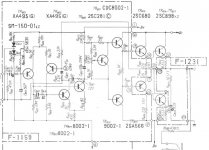Got a Sansui AU-999, and one of the driver boards has an intermittent problem that may be a flaky transistor. Unfortunately, these transistor part numbers are totally whacked!!
XA495?
CDC8002-1?
9002-1?
What in the world?? Are these Germanium?
They are certainly bizarre-looking....little white 'flying saucers' with black tops.
These numbers ring a bell with anyone?
XA495?
CDC8002-1?
9002-1?
What in the world?? Are these Germanium?
They are certainly bizarre-looking....little white 'flying saucers' with black tops.
These numbers ring a bell with anyone?
Attachments
Found this link
http://www.ecadata.de/suchneu/such.php?ECA_KEY=CDC8002
If you register there seems to be datasheets for it also
http://www.ecadata.de/suchneu/such.php?ECA_KEY=CDC8002
If you register there seems to be datasheets for it also
CDC8002/9002 are complementary pairs similar to 2N4033 and complement which at the moment escapes me. You couldeasily replace them with anything of the general sort (80V / 1A).
XA495 you could replace with whatever favorite front end transistor you use
If your intermittent problem is occasional sudden DC spike resulting in blown fuses, you may save yourself a complete change of components (which is what I did on a 999 that had this problem before figuring it out), and use a good PCB cleaner and thouroughly clean all the PCBs! Believe it or not, that was the root cause - apparently the flux used seems to be the predecessor of the infamous Sansui glue
XA495 you could replace with whatever favorite front end transistor you use
If your intermittent problem is occasional sudden DC spike resulting in blown fuses, you may save yourself a complete change of components (which is what I did on a 999 that had this problem before figuring it out), and use a good PCB cleaner and thouroughly clean all the PCBs! Believe it or not, that was the root cause - apparently the flux used seems to be the predecessor of the infamous Sansui glue
No blown fuses...what happens is that I get a gentle 'thump' through one of the channels...yes, you could call it a DC spike, but is it a gentle one. The driver boards are easily swapped from L to R and the 'thump' follows the board.
So...there is nothing really too oddball about these transistors except the looks of them?
So...there is nothing really too oddball about these transistors except the looks of them?
EchoWars said:So...there is nothing really too oddball about these transistors except the looks of them?
Exactly, and in fact, the oddball looks are the first iteration of non-metalic packaging. The package is a sort of ceramic base, plastic cover version of the TO style metal can. Even the pinout is the same. The smaller version as used on the input transistors is the predecessor of the TO92 case.
The 999 power amp is a bit of an odd-ball. On one hand it is quite advanced for the times, on the other it has a curious omission - resistor terminated VAS (from a separate higher voltage rail, this is similar to Mac amps). As a result it actually has a rather low open loop gain.
BTW you should think about replacing both transistors in the differential VAS... not overly important even though it is likely your replacement has higehr gain, there is considerable emitter degeneration... it's just... well, for me it would be like a persistant itch ;-)
- Status
- This old topic is closed. If you want to reopen this topic, contact a moderator using the "Report Post" button.
- Home
- Amplifiers
- Solid State
- Totally Unfamiliar Transistor Numbers...???
